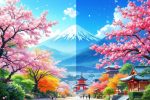The Best Time to Visit Japan: How to Plan a Trip to Japan Seasonally
Dreaming of exploring Japan? Discover the best time to visit based on your interests! From iconic cherry blossoms in spring to vibrant autumn foliage and thrilling winter sports, each season offers a unique experience. Explore our comprehensive guide, covering month-by-month weather details, regional climate variations, and top activities, from hanami picnics under blooming sakura to skiing in Hokkaido’s snowy paradise. Plan your perfect Japanese adventure today!
Important information
- Japan has four distinct seasons, each offering unique experiences: spring (cherry blossoms), summer (festivals and beaches), autumn (vibrant foliage), and winter (snow sports).
- Peak cherry blossom season is from March to April, with specific timing varying by region. Book accommodations well in advance due to high demand.
- July and August are popular for festivals but also hot, humid, and crowded. Consider September for pleasant weather and fewer crowds.
- Hokkaido is ideal for winter sports (December-February), while Okinawa offers a subtropical escape year-round.
- Pack light for easier travel and be mindful of local customs like quiet on public transport.
Understanding Japan’s Seasons
Spring (March-May): Mild weather arrives alongside the iconic cherry blossoms, creating picturesque landscapes.
Summer (June-August): Known for its heat and humidity, summer is a festive season with numerous celebrations.
Autumn (September-November): Cooler temperatures prevail as vibrant foliage transforms the scenery.
Winter (December-February): Snow blankets much of Japan, especially the northern regions, offering perfect conditions for winter sports.
Spring: Cherry Blossoms and Mild Weather
Experience the magic of spring in Japan from March through May. With mild weather, averaging 55°F (13°C) in March and reaching a comfortable 73°F (23°C) by May, spring is the perfect time to visit. Witness the iconic cherry blossoms in full bloom and partake in “hanami,” the treasured tradition of flower viewing. A host of festivals adds to the vibrant atmosphere, including the Mito Plum Blossom Festival in March and the Great Wisteria Festival, which runs from mid-April to May.
Weather
Enjoy mild temperatures, starting at an average of 55°F (13°C) in March and gradually increasing to a pleasant 73°F (23°C) by May.
Cherry Blossoms
Experience the world-famous cherry blossoms in their peak season. Participate in “hanami,” a beloved tradition of appreciating the beauty of these delicate flowers.
Festivals
- Mito Plum Blossom Festival (March).
- Great Wisteria Festival (mid-April to May).
Summer: Festivals and Beaches
Japan bursts with energy in the summer, a season brimming with festivals and beachside enjoyment. However, be prepared for heat and humidity, especially during June and July. August, the peak season, sees schools close, leading to packed beaches and bustling festivals. Plan your trip wisely.
Fall: Foliage and Cool Air
Experience Japan’s autumn splendor from September to November. The cooler temperatures create ideal conditions for exploration, ranging from a pleasant 69°F (21°C) in September to a refreshing 62°F (17°C) by November. As the leaves burst into vibrant hues, stunning scenery unfolds, especially in Kyoto and Nikko. Autumn also brings a wealth of festivals celebrating the colorful foliage and abundant harvests.
Winter: Snow, Skiing, and Hot Springs
Experience the magic of a Japanese winter in Hokkaido, a snowy paradise perfect for skiing and snowboarding. February offers prime conditions, with numerous resorts catering to all skill levels. After a thrilling day on the slopes, relax in a traditional onsen for a soothing geothermal soak.
Alternatively, December brings enchanting winter festivals and dazzling illuminations under crisp, dry skies, ideal for sightseeing. For a warmer winter escape, explore Japan’s southern islands like Okinawa, where balmy temperatures offer a unique winter experience.
Month-by-Month Climate Guide
March welcomes cherry blossoms with temperatures ranging from 8-16°C (46-61°F).
April is the best time to see cherry blossoms in full bloom, with temperatures between 13-20°C (55-68°F).
May offers pleasant weather, lush greenery, and temperatures averaging 17-24°C (63-75°F).
June marks the start of the rainy season and increased humidity, with temperatures around 21-27°C (70-81°F).
July kicks off festival season as temperatures climb to 24-31°C (75-88°F).
August is a popular travel month, but it’s hot and humid, with average temperatures of 26-33°C (79-91°F).
September brings clearer skies, fewer crowds, and cooler temperatures of 22-29°C (72-84°F).
October ushers in the fall foliage season with temperatures around 17-24°C (63-75°F).
November showcases peak fall colors as temperatures drop to 10-18°C (50-64°F).
December is cool and dry, with temperatures ranging from 5-13°C (41-55°F).
January offers smaller crowds and dry weather, with temperatures between 3-10°C (37-50°F).
February is peak ski season, and it’s cold, averaging 2-9°C (36-48°F).
March: Cherry Blossom Season Begins
Spring in Japan begins with the vibrant blooming of cherry blossoms in March, accompanied by the appearance of plum blossoms, signifying the arrival of warmer weather. Temperatures range from a cool 5°C (41°F) to a milder 13°C (55°F).
April: Peak Cherry Blossom Viewing
Experience the magic of cherry blossom season in Japan during April. Parks transform into vibrant gathering spots, where locals and tourists alike partake in hanami picnics beneath the delicate blooms. Be aware that this popular season leads to higher hotel rates, so booking your accommodations in advance is strongly recommended.
May: Pleasant Weather and Vibrant Vegetation
Experience Japan in May with delightful temperatures ranging from 15°C to 25°C (59°F to 77°F). Lush greenery transforms the landscapes into breathtaking vistas, ideal for outdoor adventures.
- Enjoy hiking amidst stunning scenery.
- Explore vibrant gardens in full bloom.
- Experience clear, sunny days thanks to the pre-“tsuyu” (rainy season) period.
While mostly sunny, be prepared for occasional showers.
June: Rainy Season and Humidity
As June arrives in Japan, so does the rainy season, lingering until mid-July. The weather turns hot and humid, with southern regions like Tokyo and Kyoto experiencing more rainfall. This makes it an ideal time for indoor pursuits. For example, you can visit museums, participate in a traditional tea ceremony, or indulge in a sake tasting. While the rain might discourage some, June presents a unique chance to explore popular attractions with significantly fewer crowds.
July: Festival Season
Experience the vibrant energy of Japanese festivals in July. Kyoto hosts the spectacular Gion Matsuri, while Osaka boasts the impressive Tenjin Matsuri. Tokyo lights up the sky with its dazzling Sumidagawa Fireworks Festival. These events offer a glimpse into Japan’s rich cultural heritage.
August: Busy Travel Period
Traveling to Japan in August? It’s a popular time coinciding with school breaks and family vacations, so expect higher prices and book accommodations early. Mid-August features Obon, a festival honoring ancestors, which increases travel, especially to rural areas. The weather remains hot and humid, so plan accordingly for a comfortable trip.
September: Clear Skies and Fewer Crowds
Considering a trip to Japan in September? It’s a wonderful time to experience Japan with pleasant weather and fewer tourists than the summer months. It’s an ideal time for outdoor activities like hiking, biking, or kayaking. While typhoon season occurs in September, landfall is uncommon, allowing you to comfortably explore attractions and enjoy the local cuisine.
October: Start of Fall Foliage
October is a delightful time to explore mainland Japan. The weather is mild and comfortable, marking the beginning of the vibrant fall foliage season. As leaves transform into stunning hues, the landscapes, particularly in mountainous and northern regions, become breathtaking. With fewer crowds than peak season, October offers an ideal opportunity for outdoor activities.
Benefits of Traveling to Japan in October:
- mild and comfortable weather,
- start of the fall foliage season,
- fewer crowds than peak season.
Recommended Activities:
- hiking scenic trails,
- exploring cultural attractions.
It is recommended to book accommodations in advance, especially for weekend travel.
November: Peak Fall Colors
Japan’s autumn scenery peaks in November, bursting with vibrant hues of red, orange, and yellow. This breathtaking spectacle draws numerous visitors eager to witness nature’s artistry.
December: Cool and Dry Weather
Cool, dry weather settles over Japan in December as winter begins, making for pleasant travel conditions.
January: Less Crowded and Dry
Escape the holiday hustle and enjoy January’s refreshing quiet. The weather is perfect for exploring, with cool, dry, sunny days ideal for sightseeing.
February: Peak Ski Season
Northern Japan’s ski resorts are bustling in February, attracting many skiers and snowboarders during peak season.
Best Times for Specific Activities
Discover the beauty of Japan across all four seasons. Spring (March-April) is famous for its fleeting cherry blossoms. Summer (July-August) vibrates with energetic festivals.
- If you enjoy hiking and other outdoor activities, spring and autumn offer ideal conditions.
Autumn (October-November) transforms the landscapes with vibrant fall colors. Winter (December-February) invites you to experience exciting snow sports.
Cherry Blossom Viewing: March to April
Japan’s cherry blossom season graces the country from March to mid-April, with peak viewing times varying by region. Nagasaki and Hiroshima typically celebrate full bloom in early April, while Tokyo’s blossoms peak later in the month. The Japan Meteorological Corporation forecasts these anticipated dates each January. April is a cherished time for *hanami* (flower viewing), attracting locals and tourists to parks, especially in Tokyo, for picnics beneath the delicate sakura. However, this immense popularity leads to larger crowds and higher accommodation costs. Consider visiting less crowded locations or traveling during off-peak times to fully enjoy the beauty of the cherry blossoms.
Fall Foliage: October to November
Experience Japan’s breathtaking fall foliage in November. Vibrant hues of red, orange, and gold paint stunning landscapes, creating a photographer’s paradise. Capture colorful photos with excellent visibility thanks to the crisp November air. Explore popular locations like Osaka Castle and Kyoto’s serene temples against these vibrant backdrops.
Festivals: July and August
Experience the vibrancy of Japan during summer, especially in July and August, with its lively festivals known as matsuri. Kyoto’s Gion Matsuri in July and the Aomori Nebuta Matsuri in August are two must-see events. These matsuri offer a mix of traditional music, energetic dancing, and tempting food stalls, culminating in breathtaking firework displays. Mid-August marks Obon, a period for honoring and remembering ancestors through peaceful reflection.
Winter Sports: December to February
Experience the enchantment of a Japanese winter from December to February. Indulge in world-class skiing and snowboarding in Hokkaido or the Japanese Alps. Beyond thrilling winter sports, discover unique cultural experiences. Picture stunning snow-covered scenery and vibrant winter festivals. Remember to pack warm clothing, particularly for the colder northern regions.
Hiking and Outdoor Activities: Spring and Fall
Spring is a wonderful time to visit, offering mild weather perfect for hikes amidst cherry blossoms and vibrant greenery. Spring boasts pleasant temperatures and breathtaking scenery.
Autumn rivals spring’s beauty with crisp air and colorful foliage, creating a picturesque backdrop for outdoor activities like hiking and biking. Visiting a local park is also recommended for admiring the fall leaves.
Travel Tips for Visiting Japan
Japan offers something special every season. Spring (March-May) bursts with cherry blossoms, creating a picturesque setting for hikes and garden visits. Summer (June-August), while hot and humid with a chance of typhoons, is alive with festivals and beach activities. Autumn (September-November) paints the landscapes in vibrant foliage, offering ideal temperatures for hiking and outdoor adventures. Winter (December-February) provides opportunities for skiing and snowboarding with the added bonus of fewer tourists.
Regional Climate Variations
Regional climates differ significantly across Japan. Hokkaido experiences colder winters ideal for winter sports, while Okinawa enjoys a subtropical environment perfect for year-round beach activities. Research specific regional climates when planning your trip.
Tips for First-Time Visitors
- First-time visitors often start with the bustling cities of Tokyo and Kyoto, exploring historical sites and modern marvels.
- For a unique cultural immersion, consider a stay at a traditional Ryokan in the countryside, experiencing Japanese hospitality and tranquility.
Respecting Local Customs
- Maintain quiet on public transport, showing consideration for fellow passengers.
- Make dietary requests ahead of time, especially if you have specific needs or allergies.
Packing Tips
Packing light will enhance your travel experience, making it easier to navigate public transport and explore different areas.
Choosing the Right Season Based on Interests
Do you adore vibrant festivals and sun-kissed beaches? Then summer is your perfect match. If crisp air and the vibrant hues of autumn leaves beckon, embrace the fall. Winter provides a unique haven for skiers, snow bunnies, and those seeking the soothing warmth of hot springs. And for those who appreciate delicate beauty and mild weather, spring offers breathtaking cherry blossoms.
Weather Considerations for Different Regions
Hokkaido’s long, snowy winters create ideal conditions for winter sports enthusiasts.
Okinawa enjoys a subtropical climate year-round, though its coastal areas are susceptible to typhoons, particularly during summer and autumn.
For those seeking cooler summer temperatures, the mountainous regions, including the Japanese Alps, provide excellent hiking opportunities.










